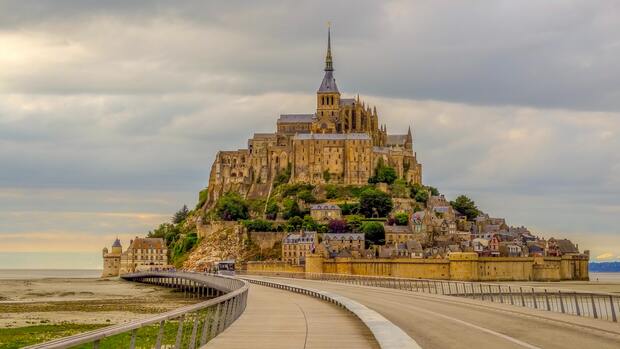
Mont-Saint-Michel is a must-see destination in France. But with more than 2.5 million visitors per year and up to 15,000 visitors per day, the prestigious rocky islet is usually packed. On the busiest days, even making a path for yourself to move forward is not easy.
So if you want to enjoy the island and its many wonders with good weather but no crowds, when should you go? Is any particular day better than others? Or is a certain time of day best? What time of year is best for a visit?
To answer these questions, we took it upon ourselves to study the subject. Here are the results.
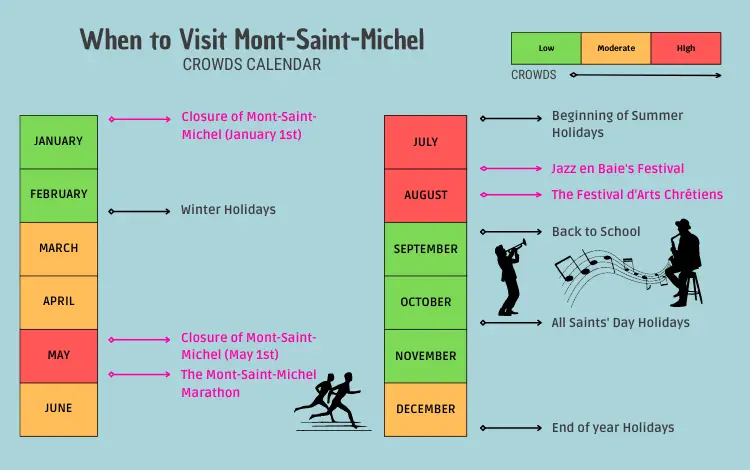
Mont-Saint-Michel is open all year except for January 1st, May 1st, and December 25th. This means that both locals and foreigners can come and visit the site at any time of the year.
On the above graphic, we can easily see that school holidays, summer, and periods with events (The Mont-Saint-Michel Marathon, The Jazz en Baie festival, etc.) are the busiest periods of the year.
But when it comes to visiting such a historical site, good organization is essential for a great trip. The weather, the crowds, and schedules (of the tides, the monuments, the museums, and personal schedules) are all things that must be taken into account.
Therefore, finding one answer to our question that fits everybody is not as easy as it seems.
Best Times to Go to Mont-Saint-Michel
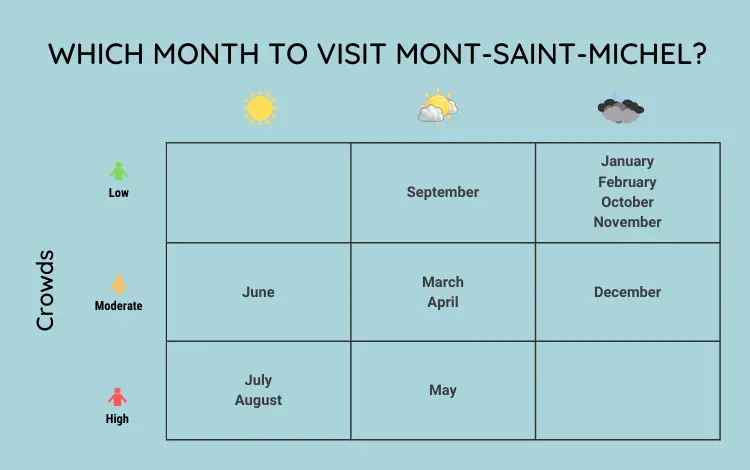
The off-peak season is from September to February (not including the end of the year break). If you want to admire the beauties hidden in Mont-Saint-Michel while enjoying the sun on an empty island, we advise visiting during the week.
For example, you should plan a trip on a Tuesday or a Thursday in September.
In September, most tourists and visitors are at school or at work, the sun is out (temperatures are around 20°C/68°F), and the island is a lot calmer than it is during the summer.
Late fall and winter are great times to visit from a financial standpoint, but the weather is also cooler and rain is more frequent. In January and in November, temperatures generally don’t get higher than 7°C (45°F) and there are approximately eighteen rainy days in each of these months.
If you want to avoid rain at all costs and get to enjoy the stunning landscapes and the sun, you should plan a trip at the beginning of September. There will still be a few tourists but far fewer than in July and August and it should still be sunny. You will also be able to admire the spectacular high tides of Continental Europe.
To ensure that you get to see these awesome tides and watch Mont-Saint-Michel turn into an island, make sure that you arrive two hours prior to the time indicated on the tides calendar (tides with a 110 coefficient are considered “high”).
If you’re planning to stay for longer than one day, be sure to check out our list of the best hotels on and around Mont-Saint-Michel (onsite hotels can be expensive!). With one of these options, you’re sure to have a great stay and get a good value for your money.
Worst Times to Go to Mont-Saint-Michel
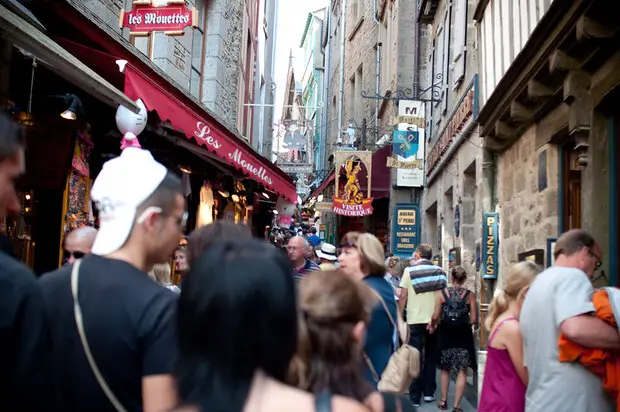
Unsurprisingly, periods with events, school holidays, and summer in general should be avoided if you want some calm and tranquility.
If you want to visit the abbey or the museums of Mont-Saint-Michel without being constantly pushed around, we recommend removing July and August from your list of options. The wait just to enter these places can be up to an hour long!
You may also have to wait for the free shuttle bus Le Passeur during the summer. (Please note that you can walk to the islet thanks to the Pont Passerelle – it will take you about 50 minutes from the Place des Navettes.)
Crowds are usually largest at this time of year also, mostly due to foreign visitors who often take one or more of the guided tours that occur throughout the day all over Mont-Saint-Michel.
During the summer holidays, the sun sets much later than usual (around 10pm), temperatures get warmer (averaging 22°C/72°F), and events are more frequent (the Festival d’Arts Chrétiens, the Jazz en Baie festival…). All of this results in larger crowds than in September, for instance.
We also advise that you avoid going on a long weekend such as those in May (Labor Day, National day, May 8th, Ascension…). During long weekends and public holidays, people have more time and tend to book longer trips. Additionally, peak seasons typically have higher prices.
If summertime is the only time of the year you are available, late July is the best time for an escapade to Mont-Saint-Michel. The last two weeks are busy, but since they come right after a long weekend (July 14th) and before August (the busiest month of the year), they tend to be a little calmer.
Be sure to take advantage of the morning hours, which are the quietest part of the day (crowds are at their highest between 11am and 4pm). The monuments and shops on the islet usually open around 9am, so if you arrive at 7:30am, you’ll be able to enjoy the relatively tourist-free island for at least an hour and a half.
The second calmest part of the day is the evening, around 7pm. At this time the shops and museums are closing and the number of visitors drops, allowing you to admire Mont-Saint-Michel by night. (The free shuttle bus Le Passeur runs every 20 minutes until midnight.)

When it comes to eating on the islet, we advise bringing your own meal. Most of the restaurants are only open for lunch, and the ones that stay open until 9:30pm can be a bit expensive.
Bringing your own food also allows you to eat at any time of the day and anywhere you want.
Tips
1) Visit the monuments at the beginning or the end of the day
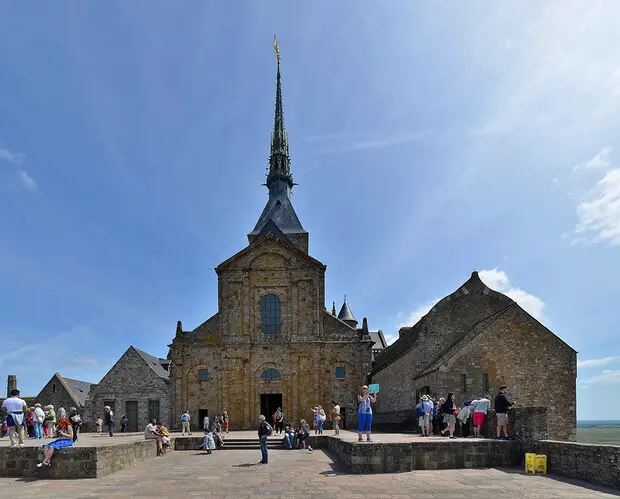
To fully enjoy the museums and heritage sites on the island, it’s best to go right when their doors open (from May 1st to August 30th, the abbey opens at 9am; it opens at 9:30am the rest of the year) or at the end of the day just before closing time (the last entry to the abbey is at 5pm).
By doing so, you are less likely to be squished by crowds and guided tours, and you’ll get to enjoy the island’s streets and village while everyone else is busy discovering the monuments and the island’s history. It also allows you to miss the long lines to enter the sites and to appreciate their beauty in peace.
If you’ve already planned your day and you want to visit the abbey during the day, you can buy tickets that allow you to enter without waiting in line.
Just be sure to check the monuments’ and museums’ schedules beforehand as they vary with the seasons!
2) Park a little farther away
There are parking lots right next to Mont-Saint-Michel, and there are shuttle buses that will take you right to the island from those parking lots. But parking your car in one of these lots can cost between €9 a €15 a day, depending on the season.
We recommend parking in the nearby city of Pontorson. It’s only a 10-minute drive away, and you can park your car for free. For a fare of around €3, the bus will take you to Mont-Saint-Michel (the bus stops at the same location as the free shuttle buses provided by the island).
3) Appreciate the peacefulness of the night
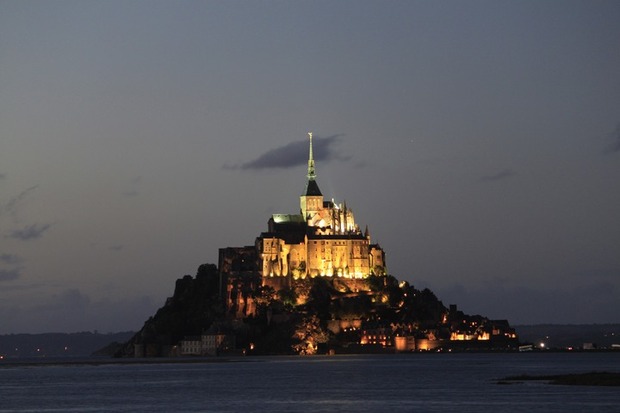
We recommend completing your visit with a stroll on the island at night. By 7pm the island is usually not as packed as it is during the day and you can appreciate the peace of the islet.
During summer, you can experience a magical moment at night. The sun sets between 9pm and 10pm, offering a stunning view of Mont-Saint-Michel.
Because Le Passeur runs from 7:30am to midnight, you can even stay to admire the quirky view of a lit up Mont-Saint-Michel before leaving.
Please note that, except for in the summer, temperatures are cooler at night, so be prepared to wear warmer clothes at night.
FAQ
When is the best time to visit Mont-Saint-Michel?
If you want to witness stunning high tides, the beginning of September is the best time (make sure to check the tide calendar).
If you want sunny weather and a peaceful island, the month of June is also interesting.
When are the crowds the smallest on Mont-Saint-Michel?
During off-peak seasons: from September to February (not including the Christmas holidays).
Please note that, while there are fewer people on the island, October, November, and December also are the coldest and rainiest months of the year.
When are the crowds the largest on Mont-Saint-Michel?
Crowds are larger during school holidays and the summer. The different events throughout the year also cause an increase in the number of visitors. This is especially true during the Mont-Saint-Michel Marathon in May.
What weekday is the least crowded on Mont-Saint-Michel?
Tuesdays and Thursdays are the calmest days. Visitors tend to book long weekends and spread their stay out over Mondays and Fridays. Because children don’t have school on Wednesdays, the crowds tend to be larger on Wednesdays as well.
What’s the best time to arrive at Mont-Saint-Michel?
If you want to visit the abbey and the island’s museums, it’s best to arrive at opening time (the abbey opens at 9am or 9:30am depending on the season, and the museums open at 10am). The free shuttle bus Le Passeur starts running at 7:30am or 8:30am, depending on the season.
Another option is to come just before the abbey and museums close (at 5pm or 6pm). Visitors generally leave between 6pm and 7pm, and aside from some restaurants, most of the island’s shops close at 7pm. This makes the atmosphere much calmer and the crowds more bearable.
We highly recommend this alternative during summer when the number of visitors is at its highest. Most importantly, in the summer you can still appreciate Mont-Saint-Michel by day and admire the sunset even if you don’t arrive until later in the afternoon. The shuttle bus Le Passeur runs until midnight, so you have no reason to miss out on the sunset and the island at night!
I aim to share my tips and recommendations for the beautiful country of France. My goal is to help you plan your next adventure, whether it’s a weekend getaway or a once-in-a-lifetime trip. From finding the best hotels and restaurants, to discovering unique activities and sights, I’ve got you covered!

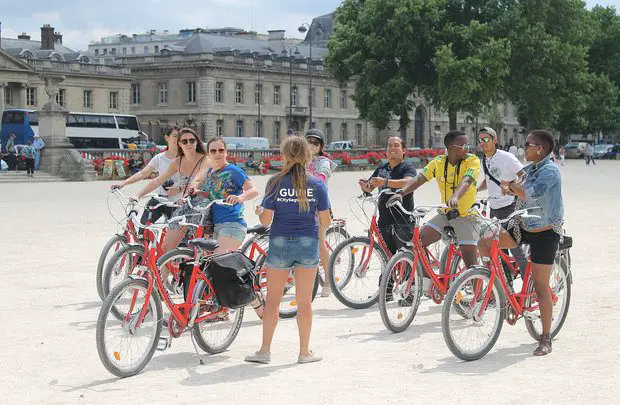
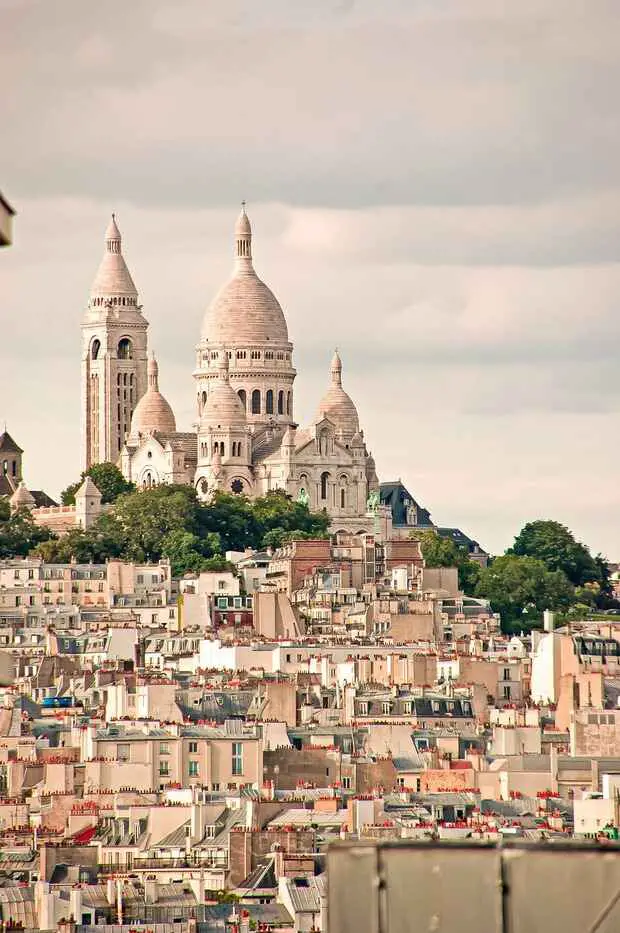


“If you want to witness stunning high tides, June is the best time (make sure to check the tide calendar).
If you want sunny weather and a peaceful island, the month of September is a better choice than June.”
Thank you for a great report, it’s most helpful. I’m wondering though why it says June is the best month to see “stunning high tides”, since if I have understood the schedule right, it would be even better in September (year 2023). In September the coef goes above 100, but it doesn’t in June. Please advise!
Hi Marie,
We have updated that part.
The problem with the tides is that the coefficients and dates of spring tides change from year to year, but it is commonly accepted that spring tides are often impressive due to a particular alignment of the Moon. Not in 2023 apparently!